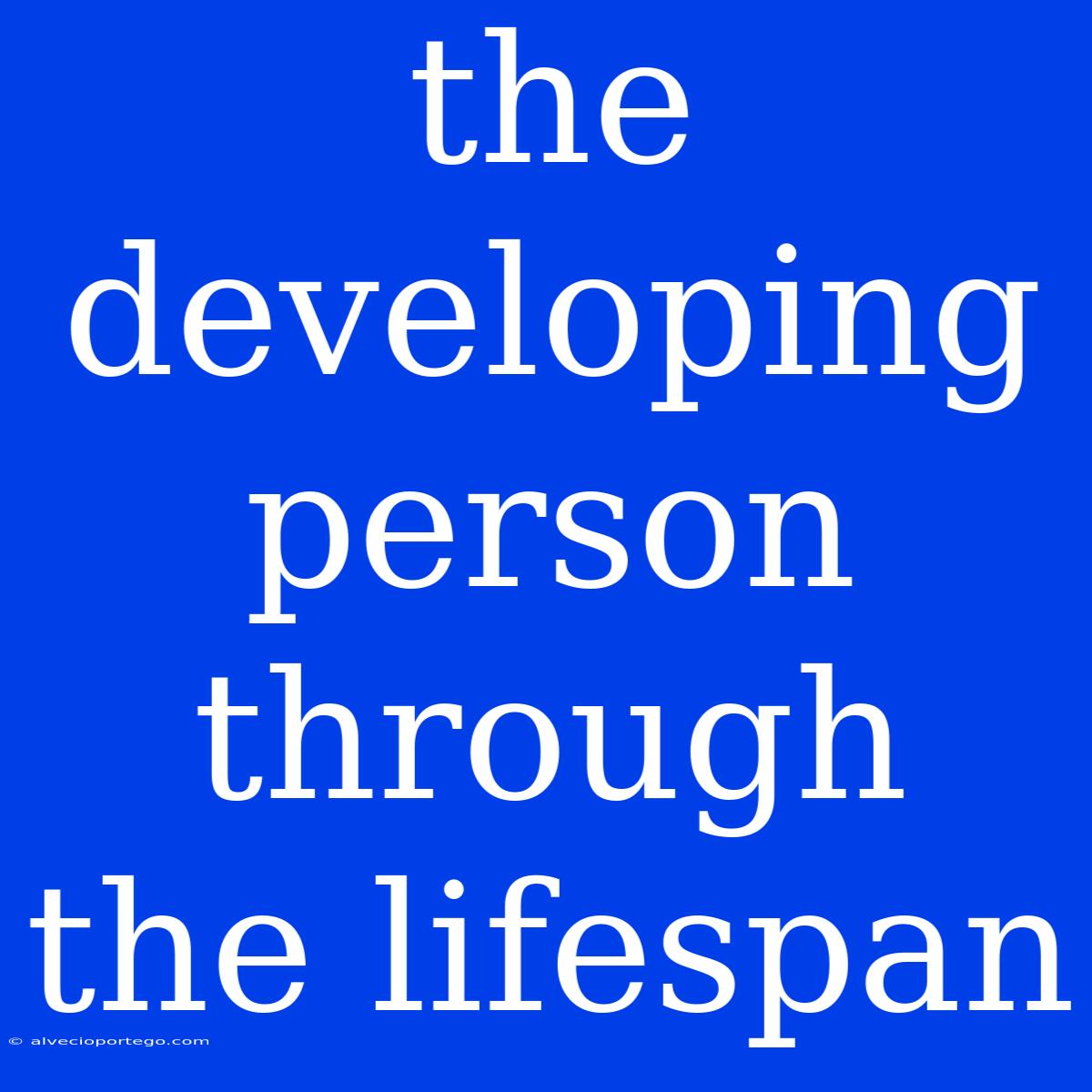The Developing Person Through the Lifespan: A Journey of Growth and Change
The human lifespan is an incredible journey, marked by continuous growth, change, and adaptation. From the moment of conception to our final days, we are constantly evolving, navigating various stages of development that shape our physical, cognitive, social, and emotional selves. This article explores the fascinating world of human development, focusing on the key stages and influential factors that contribute to our lifelong journey.
Prenatal Development: The Foundation of Life
The prenatal stage, encompassing the period from conception to birth, is a crucial time for laying the groundwork for future development. This stage is characterized by rapid growth and differentiation, with the fertilized egg dividing and developing into a complex organism.
Three trimesters mark this period:
- First Trimester: The embryo develops major organs and systems, while the fetus begins to move and exhibit basic reflexes.
- Second Trimester: Significant growth occurs, and the fetus starts to develop sensory abilities and responds to external stimuli.
- Third Trimester: The fetus continues to grow and mature, preparing for life outside the womb.
Factors impacting prenatal development:
- Genetics: Inherited traits influence physical characteristics and predispositions.
- Nutrition: A balanced diet is essential for healthy fetal growth and development.
- Environmental factors: Exposure to toxins, drugs, and stress can have detrimental effects.
Infancy and Toddlerhood: Early Foundations of Development
From birth to two years of age, infants and toddlers undergo rapid physical, cognitive, and social-emotional development.
Physical Development: Rapid growth in height and weight, the development of fine and gross motor skills, and the maturation of sensory systems are hallmarks of this period.
Cognitive Development: The ability to learn and understand the world rapidly expands. Infants develop object permanence, language skills, and early problem-solving abilities.
Social-Emotional Development: Early attachment relationships with caregivers form the foundation for social and emotional well-being. Infants develop basic emotions, learn to interact with others, and begin to explore their own identity.
Early Childhood: The Power of Play and Exploration
Between the ages of two and six, children enter early childhood, a time of remarkable physical, cognitive, and social development.
Physical Development: Motor skills continue to refine, and children gain more control over their bodies. They become more coordinated and enjoy active play.
Cognitive Development: Thinking becomes more symbolic and imaginative, allowing children to engage in pretend play and develop a sense of self and others. Language skills flourish, and children begin to understand basic concepts like numbers and letters.
Social-Emotional Development: Children develop a strong sense of self and begin to understand social rules and expectations. They form friendships and learn to cooperate with others.
Middle Childhood: Schooling and Socialization
From six to twelve years old, children enter middle childhood, a period marked by increased independence, social interaction, and academic learning.
Physical Development: Growth slows down, but physical coordination and fine motor skills continue to improve.
Cognitive Development: Thinking becomes more logical and abstract, allowing children to grasp concepts like cause and effect. They develop more complex problem-solving skills and are capable of independent learning.
Social-Emotional Development: Children become more aware of their social standing and form strong peer relationships. They begin to develop a sense of identity and explore their interests and talents.
Adolescence: Transition to Adulthood
Adolescence, from twelve to eighteen years old, is a time of rapid physical, cognitive, and social-emotional changes, marking the transition from childhood to adulthood.
Physical Development: Puberty occurs, leading to significant physical changes, including hormonal shifts, growth spurts, and sexual maturation.
Cognitive Development: Abstract thinking, complex reasoning, and moral reasoning abilities continue to develop. Adolescents become more capable of planning for the future and making independent decisions.
Social-Emotional Development: Identity formation becomes a primary focus, as adolescents navigate social pressures, explore their independence, and establish their own values and beliefs.
Emerging Adulthood: Finding One's Place in the World
Emerging adulthood, from eighteen to twenty-five, is a relatively new stage, characterized by instability and exploration as young adults transition into full adulthood.
This stage is marked by:
- Identity Exploration: Young adults continue to refine their sense of self and explore their career paths, relationships, and values.
- Instability: Many experience changes in their living situation, education, and relationships.
- Focusing on Self: Emerging adults often prioritize their personal goals and self-discovery before settling into family and career responsibilities.
Adulthood: Building a Life and Legacy
Adulthood, starting around age twenty-five, is a diverse and dynamic period, spanning many decades.
Early Adulthood (25-40): This stage is often characterized by establishing a career, forming long-term relationships, and starting a family.
Middle Adulthood (40-65): Individuals reach their peak in many aspects of life, including career success and social status. They focus on raising their children, contributing to society, and maintaining their health.
Late Adulthood (65 and beyond): This stage is marked by retirement, changes in physical health, and a shift in priorities towards personal relationships, leisure activities, and reflecting on life experiences.
Conclusion: The Lifespan Journey of Development
The developing person through the lifespan is a fascinating and complex journey of growth, change, and adaptation. Each stage brings its own unique challenges and opportunities, shaping who we are and how we interact with the world. By understanding the key developmental processes, we can better appreciate the intricate dance of nature and nurture that makes us who we are.

